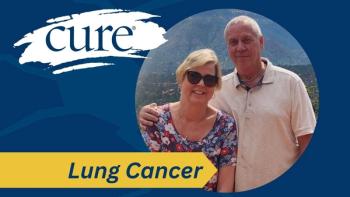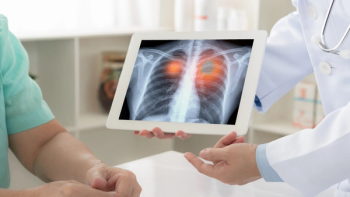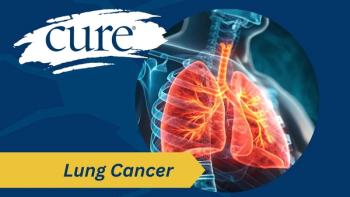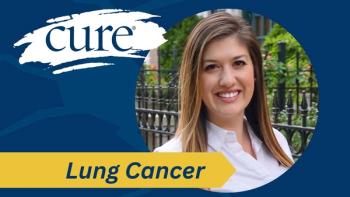
Novel Therapies for Advanced Small Cell Lung Cancer
Transcript:
Philippa Cheetham, M.D.: You’ve talked about the regime for patients with small cell lung cancer confined to the chest, the combination of chemotherapy with radiation. Let’s talk about patients who have obvious confirmed disease beyond the chest. Is it the same regime? Is it the same kind of chemotherapy medications and are the doses the same?
Edward Kim, M.D., FACP: The advances have actually come in the extensive stage population, and rightfully so. These are where we test the novel drugs. And when we first started testing immunotherapies, small cell was earmarked as one that may actually benefit a lot because it tends to be related to tobacco use and other aspects. And frankly it’s been a little slow. There had been so many other advances in so many other tumor types, but we’re finally starting to see that in patients with small cell.
We do have a drug that’s approved after chemotherapy, which is called nivolumab. That has been FDA approved. What’s also encouraging now is that we have under an accelerated approval sort of process or accelerated prioritization a combination of using our traditional chemotherapy, that’s carboplatin or cisplatin with etoposide, and adding another immunotherapy to that combination called atezolizumab. That was based on a study that was reported last fall, and we now use that as our standard of care up front in the eligible patient population.
Philippa Cheetham, M.D.: So really the landscape of treatment has changed quite dramatically even in very recent years for these patients.
Edward Kim, M.D., FACP: Finally.
Philippa Cheetham, M.D.: Finally.
Edward Kim, M.D., FACP: Finally.
Philippa Cheetham, M.D.: Yes, it’s great news that the outcomes are definitely improving with these newer treatments. But newer treatments often means combination therapies, radiation, chemotherapy. Now we’re throwing immunotherapy in the mix. Let’s talk about side effects in terms of just with the standard treatments right now with radiation/chemotherapy. How much does radiation to your chest and chemotherapy for lung cancer knock patients about? And do you find that some patients are not able to tolerate even the standard treatments before we start talking about additional newer therapies?
Edward Kim, M.D., FACP: If we are focusing on the limited stage population where it is a combination of chemotherapy and radiotherapy, when we’re going for curative intent, it’s usually tougher treatment. And that’s why we give more of the risk because we know the benefits will be higher. It is definitely tougher to take a combination of radiation and chemotherapy than either one by themselves. It leads to more fatigue. You can get an inflammation, what we call esophagitis in your esophagus that could really get irritated. Your blood counts can be suppressed, and you could be more susceptible to infections. These are more of the common things that happen, but if someone is watching their calories, keeping their fluid intake well and their immune system behaves like we think it will, then most people can get through it pretty nicely. You’re going to be a little beat up and a little tired on the back end, but we give you a break after that.
Philippa Cheetham, M.D.: A month is quite a long time for patients to be undergoing treatment. Are patients able to keep working during these treatments or is it really a month out plus or minus extra time at the end to recover? Quite a beating, isn’t it, for patients?
Edward Kim, M.D., FACP: Yes, they need a month or two afterwards, and I tell them to go on vacation as well, to do something fun. But they will have to take chemotherapy a little longer than that because the four cycles with the three weeks per cycle will be longer than the one month of radiation. It is a cumulative effect. Usually the first cycle in the first week is more anxiety. They’re nervous. They don’t know what to expect. But, when they take it, it actually isn’t so bad. And then when they get toward the end of the radiation, that’s when the cumulative effect really occurs. And I always warn people the first few weeks after you’re done, that radiation sticks around, and so you shouldn’t feel like instantly you feel better once it stopped. I tell people if they were out in the sun in the park all day, let’s say on Saturday, when would they feel the effects of all that sun exposure? Sunday.
Philippa Cheetham, M.D.: Sure. And just the physical exhaustion of going backwards and forwards to a hospital environment every day is hugely draining for patients and their caregivers.
Edward Kim, M.D., FACP: Doctors are very stressful to a lot of people. It happens all the time.
Philippa Cheetham, M.D.: Obviously, we’ve talked about the potential side effects for patients that we discuss up front, these are the risks, this is the benefit. How often do you have a patient in front of you where you say, look, there’s no way this patient is fit enough for either radiation or chemotherapy or both? In that situation, what do they get?
Edward Kim, M.D., FACP: It’s a very challenging situation, and certainly we can see some people who come in at a very late stage and their overall condition is that they’re bedbound, they’ve lost weight, maybe their liver or other aspects are not working very well. Those are people we have to have very frank conversations about, and we mostly go to supportive oncology with this. I think for any one of us, palliative care is a blessing because it means we’re talking about it, and we have the opportunity to use it. In some folks who are maybe not so beat up, maybe we can start with radiation and just a little touch of chemotherapy. But we are deviating from standard therapy, and that means our outcome may not as good. But this is where you have to tailor it to the patient in front of you.
Philippa Cheetham, M.D.: Sure. And we’re seeing patients who have lung cancer but who also have a lot of other comorbidities. Is there anything in the patient’s past medical history, cardiac disease, diabetes, immunosuppression, anything else that makes you think, well, this patient has localized small cell lung cancer, which if I’m just focusing on the lung cancer, they can get A, B and C, but this medical condition is really a contraindication to either of the treatments you’ve discussed?
Edward Kim, M.D., FACP: Yes, it’s usually rate limiting with the radiation. If somebody has a long tobacco history and has bad emphysema, radiation damages normal lung tissue as well. And we don’t want to give somebody radiation and have them end up on two or three liters of oxygen and can’t walk around because we’ve helped.
Philippa Cheetham, M.D.: Trade one problem for another.
Edward Kim, M.D., FACP: That’s right. And so that is one of the areas that’s an accumulated sort of side effect over time.
Philippa Cheetham, M.D.: So you have to look at the big picture.
Edward Kim, M.D., FACP: That’s right.
Philippa Cheetham, M.D.: Which is why it’s so important, isn’t it, to have their primary care doctor involved as well, so that we can all weigh into giving our report about the patient’s general health and fitness to undergo the treatments that we’re offering.
Transcript Edited for Clarity




